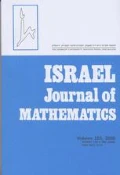Abstract
It is shown that the one electron Dirac operator in a stationary electric field is essentially self-adjoint, on the domain of infinitely differentiable functions of compact support, for a class of spherically symmetric potentials including the Coulomb potential, for atomic numbers less than or equal to 118. In addition, the domain of the closure of the perturbed operator is the same as the domain of the closure of the unperturbed operator. We also give an abstract theorem on domain-preserving essential self-adjointness for perturbed operators, which is perhaps of independent interest.
Similar content being viewed by others
References
A. O. Barut andG. L. Bornzin,SO(4, 2)-Formulation of the symmetry breaking in relativistic Kepler problems with or without magnetic charges, J. Math. Phys.12 (1971), 841–846.
F. H. Brownell,Second quantization and recalibration of the Dirac Hamiltonian of a single electron atom without radiation, J. Analyse Math.16 (1966), 1–422.
J. T. Cannon andA. M. Jaffe,Lorentz covariance of the λ(φ 4)2 quantum field theory, Comm. Math. Phys.17 (1970), 261–321, see Lemma 5.1.
K. M. Case,Singular potentials, Phys. Rev.80 (1960), 797–806.
W. D. Evans,On the unique self-adjoint extension of the Dirac operator and the existence of the Green Matrix, Proc. London Math. Soc. (3)20 (1970), 537–557.
L. Gross,The Cauchy problem for the coupled Maxwell and Dirac equations, Comm. Pure Appl. Math.19 (1966), 1–15.
K. Gustafson,A perturbation lemma, Bull. Amer. Math. Soc.72 (1966), 334–338.
K. Gustafson,Doubling perturbation sizes and preservation of operator indices in normed linear spaces, Proc. Cambridge Philos. Soc.66 (1969), 281–294.
P. R. Halmoş,A Hilbert Space Problem Book, D. Van Nostrand, Princeton, N. J., 1967.
K. Jörgens,Perturbations of the Dirac operator, Proceedings of the Dundee Conference on Differential Equations 1972, Springer-Verlag, to appear.
T. Kato,Perturbation Theory for Linear Operators, Springer-Verlag, Berlin, 1966.
T. Kato,Fundamental properties of Hamiltonian operators of Schrödinger type, Trans. Amer. Math. Soc.70 (1951), 195–211.
L. Maurin,Über die Fouriersche Losung von Gemischten Problemen in beliebigen Gebiteten fur eine gewisse Klasse von inhomogenen Differential-gleichungen mit partiellen, Ableitungen Studia Math.16 (1958), 200–229.
A. Messiah,Quantum Mechanics, Vol. 2, Wiley, 1961.
A. W. Naylor and G. R. Sell,Linear Operator Theory in Engineering and Science, Hall, Reinhart and Winston, Inc., 1971, see Th. 7.11.6.
N. Okazawa,Two perturbation theorems for contraction semigroups in a Hilbert space, Proc. Japan Acad.45 (1969), 850–853.
R. T. Prosser,Relativistic potential scattering, J. Math. Phys.4 (1963), 1048–1054.
P. A. Rejto,On reducing subspaces for one-electron Dirac operators, Israel J. Math.9 (1971), 111–143.
P. A. Rejto,Some essentially self-adjoint one-electron Dirac operators, Israel J. Math.9 (1971), 144–171.
F. Rellich, Lecture notes, Univ. of Göttingen (1953), Part II, p. 92.
M. Schechter,Principles of Functional Analysis, Academic Press, New York, 1971.
J. Schillemeit, Dissertation, Göttingen, 1954.
U. W. Schmincke,Essential self-adjointness of Dirac operators with a strongly singular potential, Math. Z.166 (1972), 71–81.
F. Stummel,Singulare elliptische Differentialoperatoren in Hilbertschen Raümen, Math. Ann.132 (1956), 150–176.
J. Weidmann,Oszillations methoden für Systeme gewöhnlicher Differential-gleichungen, Math. Z.119 (1971), 349–373.
Author information
Authors and Affiliations
Additional information
This work was initiated while both authors were guests of the Institute for Theoretical Physics, University of Geneva, Switzerland.
Partially supported by N.S.F. Grant G. P. 15239 A1
Supported by N. S. F. Grant G. P. 28933.
Rights and permissions
About this article
Cite this article
Gustafson, K.E., Rejto, P.A. Some essentially self-adjoint Dirac operators with spherically symmetric potentials. Israel J. Math. 14, 63–75 (1973). https://doi.org/10.1007/BF02761535
Received:
Issue Date:
DOI: https://doi.org/10.1007/BF02761535



